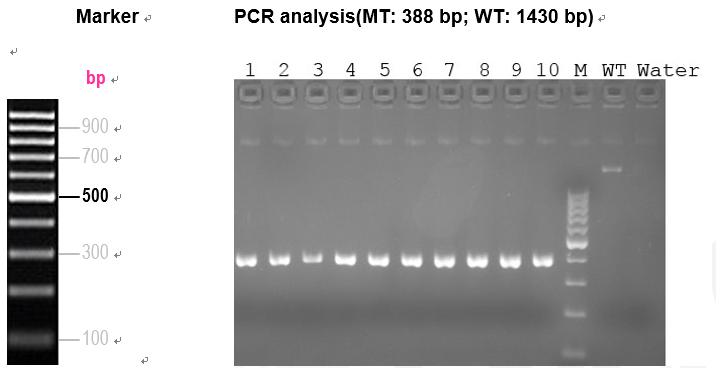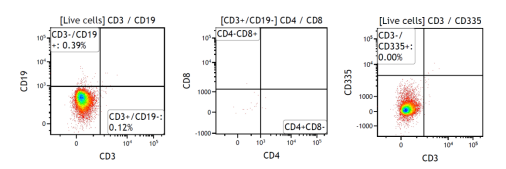
Strain Name: NOD/Shi-Prkdcscid Il2rgem1/Cyagen
Abbreviation: C-NKG Mouse
Strain Background: NOD/Shi-Scid
C-NKG mouse is a severe combined immunodeficiency (SCID) mouse developed by Cyagen through Targeted Gene Editing/Cas technology to knockout IL2RG gene on NOD/Shi-Scid background strain. C-NKG mouse lacks mature T, B and NK immune cells, so the complement activity is reduced, and macrophage phagocytosis of human derived cells is weak. This model can efficiently transplant hematopoietic stem cells (HSCs), peripheral blood mononuclear cells (PBMCs), patient-derived xenografts (PDXs) or adult stem cells and tissues. This model is recognized as having high degree of immune deficiency and has good performance in the study of tumors, immunity, autoimmunity diseases, immunotherapy vaccine, GVHD/transplantation, safety evaluation, etc.
C-NKG Features:
Research & Application:
Phenotype Validation:
1. Prkdc gene mutation

Figure 1. Prkdcscid mutation is produced by TAT → TAA in exon 84 of Prkdc gene. The sequencing result shows that C-NKG mice carry Prkdcscid mutation.
2. Il2rg gene knockout

Figure 2. The II2rg gene of NKG mouse was detected by PCR and the result shows that the II2rg gene of NKG mouse was successfully knocked out. The band size of wild type was 1430 bp and that of the knockout fragment was 380 bp.
3. Detection of B, T and NK cells in peripheral blood of C-NKG mouse


Figure 3. The peripheral blood of C-NKG mouse, a severe combined immunodeficiency (SCID) mouse model, is severely deficient in B, T and NK cells. Peripheral blood samples of BALB/c and C-NKG mice were collected, followed by the performance of flow cytometric immunophenotypic analysis and statistical comparison of the composition of T, B and NK cells. The results show that B cells (CD3-CD19+), T cells (CD3+CD19-), helper T cells (CD3+CD4+CD8-), cytotoxic T cells (CD3+CD4-CD8+) and NK cells (CD335+CD3-) in the peripheral blood of C-NKG mice were almost completely absent while comparing with BALB/c mice.
4. Detection of B, T and NK cells in lymphoid tissue of C-NKG mice


Figure 4. The lymphoid tissue of C-NKG mouse, a severe immunodeficiency mouse model, is severely deficient in B, T and NK cells. Lymphoid tissue samples of BALB/c and C-NKG mice were collected, followed by flow cytometric immunophenotypic analysis and statistical comparison of the composition of T, B and NK cells. The results show that B cells (CD3-CD19+), T cells (CD3+CD19-), helper T cells (CD3+CD4+CD8-), cytotoxic T cells (CD3+CD4-CD8+) and NK cells (CD335+CD3-) in the lymphoid tissue of C-NKG mice were almost completely absent, as compared with BALB/c mice.